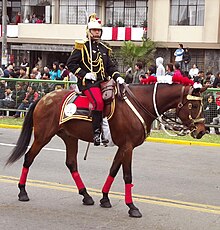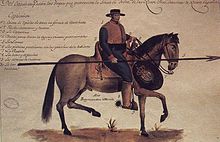dragoon

As Dragoon called one originally mounted infantry , which, unused their horses primarily for transport but for the fight. Over time they developed into battle cavalry almost everywhere . In some armed forces, some regiments still use the name in the association name for reasons of tradition .
etymology
The designation came at the beginning of the 17th century in France and probably derives from an as dragon designated handgun from that also carabine was called (see carbine ). Therefore, in some European countries, mounted infantry, including motorized or mechanized infantry today, as in the Belgian army , is called carbine .
Another explanation is that those horsemen who carried a dragon shield on their lance during the processions of the Pope as a symbol of the devil , were called draconarii ("dragon soldiers"). The word dragoon is said to be derived from this.
Historical development

The branch of service of the Dragoons was possibly by Count 1543 Piero Strozzi or 1550 by Marshal Charles de Cossé-Brissac invented. Dragoons were already used in large numbers in the French Huguenot Wars of the late 16th century. In the older German-language literature there is the claim that Count Ernst von Mansfeld (1580–1626), one of the most famous mercenary leaders and entrepreneurs of the Thirty Years' War , was the "inventor" of the Dragoons, which is not true, because Dragoons as early as 1602 are proven in the imperial Habsburg army . It is true, however, that Mansfeld occasionally made large parts of his infantry mounted with pack horses or prey horses in order to gain mobility; Even in his day this was called an armée volante . In 1635, the French army formed six regiments from existing dragoon units . In 1638, Dragoons became the official name for French foot soldiers on horseback. Dragoons were used in both the Thirty Years' War and the English Civil War .
Dragoons usually did not wear armor , but in the 16th and 17th centuries some of them protected themselves with a simple helmet and a leather collar . They were armed with a musket or a Pike , for the scuffle they had swords . The dragoons required less intensive training in riding than cavalrymen, who had to deal with their horses in combat situations. In addition, dragoons only used light riding horses, which were significantly less expensive than the battle horses of the heavy cavalry. Their advantage over the infantry was that they could get to a specific location on the battlefield more quickly . During the English Civil War, the Dragoon Regiment of the New Model Army succeeded in the battle of Naseby in 1645, to ride unhindered on the right flank of the opposing army. Then the dragoons got off their horses and attacked their surprised opponents. As a hybrid of infantry and cavalry, the dragoons were often ridiculed by soldiers from other branches of the army. An exemplary mockery of the dragoons read:
"Dragoons are half human, half cattle, infantry on horseback!"
Because dragoon units combined high mobility with relatively low costs, their numerical strength increased significantly by the early 18th century. In 1658 there was only one French dragoon regiment, in 1690 there were already 43 regiments. Under Peter I , the number of Russian dragoon regiments was increased from two to 30, which can be explained in particular by the lack of high-quality horses.
As early as the late 17th century, the English dragoons were part of the heavy cavalry . Under Frederick II , the Kingdom of Prussia also followed the English example. In France, the dragoons were officially classified as cavalrymen only from 1784. The British even carried out the gradual renaming of the original cavalry, with the exception of the guards, to Dragoon by around 1800 (the cuirass had long been abolished here anyway).
Most of the time, the dragoons belonged to the heavy cavalry and attacked like the cuirassiers with the pallasch , in Prussia they were part of the light cavalry and equipped with a saber around 1800 , in Great Britain both were available at the same time, in Austria the middle of the In the 18th century, six regiments of Chevaulegers formed from 1798 to 1801 as light dragoons and converted them into normal kuk dragoons in 1851 .
In the 19th century, many dragoons wore cavalry helmets, light dragoons were based on the infantry in this regard ( shako , later spiked hood ).
The cavalry troops of the US Army it was mostly to Dragoons.
Despite this development, the dragoons in most armies retained equipment ( bayonets ) and training that enabled them to fight dismounted as infantrymen. Echoes of infantry origin lingered in the uniforms and traditions of the dragoons. They often used drums instead of trumpets and flags instead of standards . Similar to the infantry, in some armies there were also grenadiers on horseback as elite companies that were also armed with hand grenades until the early 18th century . At the beginning of the 19th century the infantry features were mostly lost in the appearance of the dragoons, who were now considered full-fledged cavalrymen.
With the trench warfare of World War I, the role of cavalry as a battle cavalry also ended. Where the cavalry was not disbanded or motorized while retaining the old traditional name, it was only used in the classic dragoon task of mounted infantry. But even if cavalry was still occasionally used as mounted infantry in the combat areas on the Eastern Front with little road access - mostly to secure rearward areas - all-terrain personnel transport vehicles displaced the horse in this rediscovered task. The successor to the mobilized infantry were the Panzer Grenadiers .
After the end of the war, the horse disappeared as a means of transport from the stocks of European and North American armed forces. Only the Swiss Army held on to it for longer. The 18 dragoon squadrons in Switzerland , which were disbanded in 1972, were the last real cavalry in Europe.
Dragoons in today's armed forces
For reasons of tradition, some regiments in some armed forces still have the term Dragoons in the association name, such as the three British regiments 1st The Queen's Dragoon Guards , Royal Scots Dragoon Guards and Royal Dragoon Guards , which, according to their origins from the heavy cavalry as Dragoon Guards, are part of the armored force are. The Light Dragoons regiment has a role as a reconnaissance troop unit.
The French 2e régiment de dragons, on the other hand, is part of the NBC defense force , while the 13e régiment de dragons parachutistes is part of the airborne force . Only the 5e regiment de dragons is part of the armored force and serves as a training regiment there .
In Peru, the presidential guard established in 2012 bears the name Regimiento de Caballería Mariscal Domingo Nieto.
The Brazilian 1st Regimento de Cavalaria de Guardas is nicknamed "Dragones de la independencia", but is armed with lances for the representation service as presidential guard and is therefore actually part of the Uhlans .
In Denmark there is the Jutland Dragoons regiment, one of whose three battalions is the only tank battalion in the Danish army.
Police dragons
Because of their training for service on foot and on horseback and their mobility, the Dragoons were particularly suitable as police or occupation troops . In the Huguenot Wars, for example, French dragoons were forcibly quartered in Protestant villages as a punitive measure (dragoons ). In view of the versatility and mobility of the dragoons, police troops were organized in some states according to their model, for example the police dragon corps of the Duchy of Oldenburg . At the beginning of the 18th century, a highly specialized colonial police force, the so-called leather dragons ( Dragones de Cuera ), was created in the viceroyalty of New Spain . They were named after the cuera , a leather armor similar to the Aztec cotton armor , which was worn over the normal uniform. The leather dragons were mainly used in the north of the Viceroyalty to secure borders and to protect Christian missions against Indian tribes such as the Comanches . The force was taken over by the Mexican National Army after Mexico gained independence and disbanded in the 1840s.
literature
-
Liliane and Fred Funcken :
- Historical uniforms (1). 18th century. French guards and infantry. British and Prussian infantry. Mosaik Verlag, Munich 1977, ISBN 3-570-04361-4 .
- Historical uniforms (2). 18th century. French, British and Prussian cavalry and artillery. Infantry, cavalry and artillery from other European countries. Mosaik Verlag, Munich 1978, ISBN 3-570-01865-2 .
- Historical uniforms (3). Napoleonic period. French regiments of the line, British, Prussian and Spanish troops from the time of the First Empire. Mosaik Verlag, Munich 1978, ISBN 3-570-06389-5 .
- Historical uniforms (4). Napoleonic period. French Imperial Guards, Allied troops, the Swedish, Austrian and Russian armies at the time of the First Empire. Mosaik Verlag, Munich 1979, ISBN 3-570-05449-7 .
- Historical uniforms (5). 19th century. 1814–1850: France, Great Britain, Prussia. Infantry, cavalry, technical troops and artillery. Mosaik Verlag, Munich 1982, ISBN 3-570-04961-2 .
- Historical uniforms (6). 19th century. 1850–1900: France, Great Britain, Germany, Austria, Russia. Infantry, cavalry, technical troops, artillery. Mosaik Verlag, Munich 1983, ISBN 3-570-01461-4 .
- Richard Knötel , Herbert Knötel, Herbert Sieg: Colored Manual of Uniform Studies. (2 volumes). Augsburg 1997.
- Herve de Weck : Illustrated history of the cavalry. Verlag Huber Frauenfeld, Stuttgart 1982, ISBN 3-7193-0762-X .



